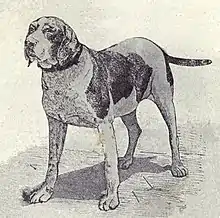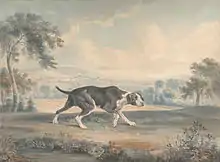Old Spanish Pointer
The Old Spanish Pointer, or Perro de Punta Español, is an extinct breed (or landrace) of dog originating in Spain, believed to be the ultimate ancestor of almost all pointing dogs.
| Perro de Punta Español | |||||||||||||||||||||||||||||
|---|---|---|---|---|---|---|---|---|---|---|---|---|---|---|---|---|---|---|---|---|---|---|---|---|---|---|---|---|---|
 Old Spanish Pointer in 1915 | |||||||||||||||||||||||||||||
| Other names | Old Spanish Pointer Spanish Pointer Old Spanish Perro de Punta Braco Español | ||||||||||||||||||||||||||||
| Origin | Spain | ||||||||||||||||||||||||||||
| Breed status | Extinct | ||||||||||||||||||||||||||||
| |||||||||||||||||||||||||||||
| Dog (domestic dog) | |||||||||||||||||||||||||||||
History
In 1644, Alonso Martínez de Espinar described the forerunner of the modern pointers as "a very hard-working animal, with an inexhaustible agility which endures running from morning to night without stopping. Some are so light that they seem to fly above the ground and skillfully tracking and stopping at the spot where the bird is which is being hunted by those behind them."[1]
Although Spain is the origin of the pointing dogs, the British most often mentioned the Spanish Pointer and brought the dogs to England in the 17th and 18th centuries.[2] Stonehengue, a pointer cinófilo scholar, wrote in the late 19th century, that the dog was selectively bred to be faster by only using lighter and faster specimens.
David Taylor, a veterinary who runs an international veterinary organization, stated that the Spanish Pointer was introduced in Britain and crossed with Greyhounds and English Foxhounds, resulting in the English Pointer.[3][4]
Similarly, in Germany in the 17th century, the German Shorthaired Pointer was the result of crossing German hounds, Spanish Pointers and Bloodhounds.
The pachón navarro is generally seen as the dog breed most closely resembling the Old Spanish Pointer.[5]
Last records

The oldest recorded painting of the Spanish Pointer in England is a painting by Peter Tillemans, created in 1725.
Stories report that during the Spanish Civil War, a Portuguese merchant took one Spanish Pointer from Spain and gifted it to Baron Bichel of Norfolk.
British breeding
According to Williams, the British found the dog to have some defects:
"They came to the conclusion that this breed had to be remodelled. The English wanted more speed, more temperament, and enough endurance to be able to withstand a full day's hunting and also to condition the dog to work both in flat terrain and difficult terrain and keep the hobby of hunting and energy for each day, in total was only to preserve its ability to finesse nose. To achieve this, they were crossed with several breeds, especially the foxhound breeds, were made numerous attempts. Carefully they selected individuals to continue reproduction. Disappeared the fat head with the big ears and stayed with the head having now one, a dry head, lower with fine ears. Expressive and always a dark shade eyes and the nose more square with cut straight and dark and with large open nostrils. It is a noble head the very broad chest of Old Spanish Pointer, stayed narrower, but more background. Some that left the freest lungs and therefore with more capacity. The ribs of the old dog were more rounded and now being less curved gave more freedom to the muscles."[6]
See also
References
- Chapter XXXVII of Arte de Cetrería
- ""Perros De Muestra Españoles", TrofeoCaza.com". Archived from the original on 2016-03-03. Retrieved 2016-01-06.
- "El Perro de punta español", Los Pointers de Alcatea
- Taylor, David. ''The Big Book of the Dog''
- "En Defensa del Perro de Punta Español", Criadero de Fiaske Desde 1971
External links
- Arkwright, William (1906). The Pointer and His Predecessors: An Illustrated History of the Pointing Dog from the Earliest Times. A. L. Humphreys.
The Pointer And Its Predecessors.
